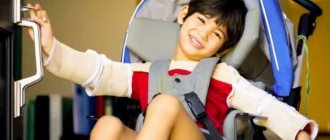Should we be afraid of fear? This feeling is familiar to everyone, and in itself does not scare anyone. Everyone has long known that every fear, even the most ridiculous, is a normal defensive reaction. It would be strange if it happened differently. But with ordinary fear, everything is easily realized, and the person knows what exactly he is afraid of and what causes the fear. The situation is completely different with obsessive fears and phobias. At first glance, they have the same functions, but still experts consider them neurotic symptoms. And if we talk about the causes of phobias, they largely remain mysteries.
A pilot study and a pivotal study are planned to bring the device into the clinic. Aline de Araujo, 28, has lost count of how many attacks she has seen from the window of her apartment in Interlagos, south of Sao Paulo. Fearing children are being kidnapped by thieves in car thefts, Sao Paulo families are committing traffic violations such as not wearing seat belts or placing the seat in the front seat. Experts warn that strategies that violate the Traffic Code very seriously increase the likelihood of accidents.
For example, what can you say about a person who is afraid to walk? Surprisingly, this also happens. The fear of standing on your feet or walking without having a point of support is called ambulophobia. This phobia is sometimes called basophobia. Ambulophobia is much more common than one might imagine, and experts say that this disease also accompanies asthenophobic syndrome. So what does it look like and how does a person suffering from this phobia feel?
Mother of Letitia, 4, Alina does not ignore the risk, but tries to balance it. It's strange to think about choosing between the same thing. On a 4-kilometer round-the-world trip between home and school, the girl is given a car seat. The mother also doesn't wear a belt: "Just in case, you need to get out of the car and get it."
She says she never took the ticket. “Between breaking the law and being attacked, we are breaking the law.” On the first day of David's sixth grade class, she saw a robbery in front of the car where she was with a boy and the youngest, Caroline, aged two. According to sociologist and transport education specialist Eduardo Biavati, parents' attitudes are "understandable" due to fears of urban violence. “This is not a fantasy, a hallucination.” But he points out that clashes have become more frequent. This is not the smartest solution.
Ambulophobes prefer to move while having a point of support, and it doesn’t matter what it is. Perhaps it will be a cane, the hand of a companion, or the person simply walks along the wall of the building, constantly touching it. When going up or down the stairs, the patient must hold on to the railing. It seems to him that as soon as he takes one free step, without relying on anything, he will definitely stumble, lose his balance, and end up lying on the floor or ground with injuries and fractures.
Instead of eventually taking risks, they continually take risks. For Fabio de Cristo, a specialist in traffic psychology, the choice between protecting yourself from an accident or being attacked may come down to the need for parental supervision. The risk is perceived as less than the risk of robbery. An attack is a complete loss of control,” he says.
Her experience heightened fears that bus driver Fernanda Santos, 26, had been abused. At 7 months pregnant, the bus he was working in Diadema, in Greater Sao Paulo, was robbed. A comfortable child gets stuck only on the belt of the car. Four months ago, the parents of 7-year-old Isadora went through a frightening approach with their child in the car.
This phobia belongs to panic disorders, and, after conducting multiple studies, scientists tend to think that its origin has to do with a certain event that occurred in childhood, but left a special imprint on the psyche, and ultimately resulted in such a bizarre fear.
Nervous, Isadora, who was in a wheelchair, had a hard time giving up. “The guy let go of the gun, took it and gave it to me.” Despite the result without a physical attack, the girl was injured. "After that, she said she didn't want to sit in the chair anymore because if she saw a bad guy, she would jump in the front seat and come with me."
Statistics. The Department of Public Security said vehicle thefts in the capital and greater Sao Paulo fell by 10.5% from January to July compared with the same period last year, reflecting the "teamwork" of police who are fighting it and all kinds crimes. Detran Sao Paulo emphasized the rules for transporting children in vehicles.
It should be noted that ambulophobia is more common in children, and there is a rather simple explanation for this. Taking his first steps, the baby does not always gain a positive experience, and if there are no mother’s hands nearby to catch the little man in time, a fall is inevitable. For most children, such trifles, in general, do not entail serious negative consequences, since children are very inquisitive, and minor troubles when falling do not frighten them.
As long as man is under the dictatorship of limited intellectual beliefs, the fire burns. Shamanism allows us an extraordinary reconciliation with the elements of nature. This is an extraordinary show that shows the power of our consciousness and the value of the work of emotional release.
The training, which lasts several hours, consists of teaching participants to externalize their emotions, then changing their level of consciousness and creating deep serenity within them. In this meditative state, they experience a sense of oneness with nature and all the elements that make it up.
But some kids are especially sensitive and have a vulnerable psyche. Over time, they begin to move more confidently on their own, but at the same time try to constantly hold on to furniture and various objects in the room. It is very difficult to lure them into the middle of the room and force them to take steps without a support point, and it takes a lot of effort from the parents for the child to overcome this fear and begin to walk boldly, confidently stepping over obstacles in the form of scattered toys.
He ceases to be an enemy who hurts us, he becomes a wonderful friend who invites us to dance with him. This extraordinary complicity, this warm intimacy that comes from feeling at one with the life of glowing coals, allows us to step out for a moment of acquired beliefs that told us that fire burns and bruises. If we had done the same without preparation or change of consciousness, one step on the coals would have sent us to the hospital with severe burns.
If your path is open, then you do not feel the fire like your enemy. You feel it like your husband or your wife. You feel the love for fire. What you see is not a mountain, it is nothing. That's how you enter it, freely. If you wanted to do this with your personal will, you would have doubts and fear. The fire will look like an enemy, like a mountain. But if your courage comes from a saint, then you can go into the fire without any problem, you are different.
It happens that ambulophobia is associated with severe diseases of the musculoskeletal system. A person who has suffered a serious illness, and has been bedridden or wheelchair-bound for a long time, is very wary of moving independently, and as soon as he finds himself without a point of support, for example, without crutches, which have long been no longer needed, it seems to the patient that he will immediately lose equilibrium. Even taking into account the fact that the patient himself understands the groundlessness of fear, nevertheless, he does not try to fight his fear, and the main thing for him is not to be left alone, and to go somewhere, or even to stand still.
He danced on fire without any problems, proving that the same altered state of consciousness can be created by different spiritual traditions. “It is fear that burns, not fire,” says Ken Cadigan, who is one of those modern shamans with a transcultural and universal message.
From: The Power of the Shamans of the Christian Tal Schaller. Evening preparation required. Surprise was the decisive emotion to accept this method, giving me a reflexive return to this one. Walking around the city allowed me to observe on the spot how people interact with urban night spaces. However, walking at night in Johannesburg is quite difficult, in a city characterized by a culture of fear. Surprise was a key emotion in this regard: it made people willing to participate, but also reflective thinking about the methodology.
Signs of the disease
Depending on the degree of the phobia, its signs may vary. If the disease is mild, then the person is quite able to control his behavior and tries not to show his condition to others. He only constantly tries to lean against a wall or furniture, leans on a cane, sometimes clearly symbolic, very thin and almost weightless, but this gives the person suffering from ambulophobia confidence and helps to overcome the necessary distance. When a phobia takes the form of a panic disorder, a person really suffers, since the manifestations of the disease are very pronounced. As a rule, this is a rapid heartbeat, dizziness, and changes in blood pressure. The patient feels weak, his knees tremble, and it seems as if the ground is literally disappearing from under his feet. During the moments of an attack, a person is really sure that he is in mortal danger. But as soon as you help the patient move to a place that is safe, in his opinion, the ambulophobe quickly calms down.
Mirroring interviews aimed at enriching the data, aimed at understanding verbalizations, but more importantly, non-representational modes of communication, allowing the discussion of bodies, emotions, feelings along with words and ideas. Navigating between discomfort, fear, frustration and pleasure, city walks interrogate Johannesburg's nighttime spaces while also allowing for some appropriation. The area of research reported in this article was supported by the Institut François d'Or.
As indicated by the terms "fear" and "desire" in the title of this memoir, imaginary and practical are deeply informed emotions, defined as psychophysiological reactions to the environment. Because of this inadequacy, the method intended to capture the emotions associated with the night itself evoked an emotion: amazement. Between reality and pretext. Years later, despite municipal efforts and an actual drop in crime rates, Johannesburg's image is slowly evolving. The culture of fear, in the sense of the constant fear that pervades the beliefs and practices of individuals, but also in the sense of the set of practices that support it, makes the night a space-time emptied of any presence in the imaginary.
First of all, it should be taken into account that the treatment of any disease, including phobias, must be carried out by a qualified specialist, and the use of various folk methods or pharmaceutical drugs without consulting a doctor is unacceptable, even if it is known that this particular remedy helped someone similar situation. Everyone is sick in their own way; this familiar phrase cannot be ignored. If a person has developed a phobia, he should consult a psychotherapist.
However, an in-depth exploration of nighttime spatial practices allows us to qualify this vision of Johannburg's nighttime spaces and highlight its instrumentalization in social relations at the intersection of class and race. It's about moving from one point to another.
However, this “spectrum” of approaches is not as linear as the typology above suggests: improvisation and spontaneity can emerge in courses, and vice versa. For example, fear may lead some of my interlocutors to adopt demarcation routes. My interlocutors were put in a situation to improvise an overnight journey, and while some people bowed to playing the walk or even wandering, others hung as much as possible up to the known elements while moving towards the course.
Where does treatment begin? The doctor will try to identify the source of fear, find the cause, and then, using special techniques, will defuse the accumulation of unwanted emotions. The patient must re-experience a certain negative episode, and although unpleasant experiences will arise, gradually the fear will melt and completely disappear.
Many people are constantly under psychological and physical stress because they are afraid of the opinions of strangers
. They are dependent on what others will say about them or what they will think, so their behavior is often limited by this fear that controls a person’s life. Often the crowd makes a choice for a person, and under its influence he loses his individual qualities and suppresses his true desires and needs. How can you learn to act and live calmly, without fear of what others will say or think?
Emotion evoked by method: amazement
Their nightly reference universe for most of them consists of a juxtaposition of private places, most often associated with car trips.
The night space is mostly interrupted. Night has the ability to make foreign familiarities, which makes its context increasingly likely to evoke feelings such as anxiety, fear, dread, discomfort, etc. People who did all three steps responded differently to each tool. The interview, a fairly classic academic research method, did not elicit any particular response. In some cases, it is useful to listen to someone else’s opinion and pay attention to an outside view, but psychologists remind us that paying attention to someone else’s opinion and depending on it are two different things. In the first case, a person uses his protective function, trying to gain benefit with the help of someone else's life experience; in the other case, he is completely deprived of his own “I”. People with low self-esteem and problems with self-perception form an idea of themselves based on the opinions of others. It is extremely important for them how others see and evaluate them.
However, if the surprise of my interlocutors contributed to the acceptance of this stage of my methodology, it also helped me to learn about the whereabouts of this tool. This special mode of visual attention to space, called "floating", is distinguished by the loafer.
The prism of distance, my own distance from the codes of place, evoked a special emotion here: amazement. It reminded me of the inadequacy of my expectations, both as a researcher and as a foreigner, about the urban context of Johannesburg and allowed me to better understand that context. At the same time, this surprise aroused respondents' interest in a practice that was outside their usual practice. Thus, the fact of “out of place”, alien to the implicit social rules that governed the appropriation of urban space at night in Johannesburg, allowed me to better reveal them by breaking them.
How to get rid of dependence on other people's opinions
First of all, you need to understand that a person cannot be the center of the Universe so that his every slightest action is acutely perceived by others. In fact, most people are busy solving their own problems, and there is no need for them to waste their energy thinking about other people's actions and words. To test this, you can perform a non-standard act that no one could expect from a person. He will soon notice that his action caused a reaction only among relatives, friends and some acquaintances. You also need to remember that people's opinions are subjective, and they tend to change. For example, a young man with long hair attended college, for which the guys from the group made fun of him more than once. But soon it became prestigious, fashionable to grow hair, and the same guys who laughed at him grew their hair.
In connection with work that emphasizes the importance of places in the constitution of individual and social identity, it seemed important to give space to the experience of urban night spaces in my methodology in order to obtain data other than that from the interviews that would likely confirm it, qualify it or even makes it invalid.
Whether walking, walking or wandering, depending on the choice of my interlocutors, the place then has the function of stimulating memory, but also provoking different emotions that the interlocutor is in regardless of whether to verbalize, silence here is as important as speech acts. We consider sensitivity as the expression of speech, and local sentiments as the causes of verbalization. The researcher makes urban travel a methodological tool because the word is placed in the place of residence to be stated during the steps.
What time does the baby start walking?
If the baby develops well, there are no diseases or delays in development, then by 18 months children usually begin to walk. Doctors set a fairly long period of time from 9 months to 1.5 years.
There are several factors that determine how early your baby will go:
- Hereditary predisposition - if one or both parents went late, then their child is likely to go about the same.
- Gender - Girls usually start walking earlier than boys.
- Body type - well-fed babies begin physical activity later than their thin peers, not only walking, but also rolling over, sitting down and standing on their feet.
- The general character is that restless people tend to conquer this world, while contemplators wait for the right moment and approach the process of independent movement more cautiously.
To be self-confident
People feel his lack of self-confidence.
In many ways, the attitude of others to what a person does depends on himself and his inner feelings. For example, if a person puts on bright yellow sneakers and at the same time feels insecure and uncomfortable, his condition is transmitted to others and becomes a reason and additional confirmation for people that their opinion is the only correct one. This is a way of self-satisfaction at the expense of another person.
The paroxysmal function of the night, as it enhances and reveals the emotions that the city evokes, is what motivated the choice of a methodology that left all its space for emotions, by recreating the conditions of its appearance. This place crystallizes many discourses about the dangers exerted in particular by Maboneng's security guards, who advise against venturing outside the airway at night. She then called it "no walking." The place seemed threatening to him because there were no more guards and there was no light.
This bodily display of emotion and the contrast with what was said during the interview allowed me to better understand how fear takes over the body and limits urban practice in an almost visceral way. This logic in the work on the study of night spaces also exists, to a lesser extent, in the awareness of the residents of the area, the spaces of the day. I got the impression that we were entering their territory. . In this respect, their appropriation of space reflects the same confusion between public space and private space demonstrated by Djemila Zeinidi in relation to homelessness: some parts of public space become places of residence, in places more quite public, but not completely private.
You cannot allow others to satisfy their needs at the expense of others. If a person wears yellow sneakers with pride, without feeling any awkwardness, feeling like a unique being who has the right to dress the way he wants, if this is the need of his soul, and he respects this need in himself, then those around him will have to respect to his choice.
All people in society, one way or another, have to take other people’s opinions
, because there is no absolute freedom, including from the opinions of others.
This is how the world works, as mentioned above, this has its advantages, you just need to be able to listen to yourself and trust your feelings, to be a person who recognizes the right of every person to self-determination. Accepting yourself is not easy, but once you do this, the fear of other people's opinions
will quickly disappear.
Why is a 1-1.5 year old child afraid to walk independently without the help of his hands?
There are many physical and psychological reasons why a child refuses to walk on his own.
Doctors and psychologists call the following:
| Cause | Description |
| The most dangerous is a health problem | Delayed motor development, muscular dystonia and other diseases. But in this case, other motor skills will appear much later. |
| The most common is a weak muscle corset | The muscles of the baby's legs and spine are not yet ready for such loads . As one wise grandmother said: “There is a time for everything.” As soon as the baby feels confident in his body, he will begin to walk. |
| Fear of falling | According to child psychologists, if a child does not have any health problems, then he does not start walking for this very reason. Perhaps when he first tried to take an independent step, he fell and hit himself hard. In order to avoid negative experiences in the future, the child refuses dangerous experiments . |
| Laziness | Another fairly common reason. Nowadays there are quite a lot of all kinds of devices for kids. Walkers are very popular with many parents. There are different opinions on this matter, but there are still more negative aspects in using walkers . Apart from the fact that they put a lot of pressure on the musculoskeletal system, they also develop laziness in the child. It is easier to move in a walker, and when parents refuse a walker and confront the child with the need to walk with his legs without any help, the baby returns to the safest and easiest way to move - crawling. |
These are the reasons why experts highlight reluctance to walk.
But they also say, as any mother can attest, that every child is unique and develops according to their own personal schedule. Even in the same family, children begin to walk at different times.
One mother shared her memories: “The eldest daughter was already running vigorously around the room at 8 months, and the youngest son, at 1.2 months, just began to take his first careful steps.”
Often, psychologists ask parents whose children begin to walk, past the crawling stage, to teach their children to crawl in a playful way.
According to research by neuropsychologists, “crawling” babies are more successful in their studies in the future, and they find it easier to learn exact sciences. And in general, crawling promotes a more harmonious development of the brain hemispheres.
Therefore, you should not rush your child to start walking as soon as possible; let the young explorer explore the world through the touch of his palms to various surfaces.
Advice from psychologists in this situation
When raising children, it is very important not to be influenced by the child’s whims and not to teach them to be carried in their arms - this can become another reason for refusing to walk independently. In addition, professionals pay attention to the following:
- Do not shout or shame the baby, this will only aggravate the situation and lead to stress;
- cuddling and being more gentle and affectionate with the baby is the key to success, because parental support is very significant for children;
- be sure to physically develop the little person, so it will be easier for him to take his first steps without fear;
- It is necessary to go with the toddler to the playground or any place where there are children. He will see kids who walk and run calmly and without fear, and, undoubtedly, will begin to repeat after them;
- set an example and give space. A child who is limited to a playpen or walker in a small room will have a more difficult time moving long distances in the future. Take the baby and go, for example, to the beach - there is a lot of space there, and he himself will be interested in leaving his own footprints in the sand.
With patience and some effort, you will be rewarded with your baby's first steps
Reasons why a child is afraid to walk independently
- Most often, refusal to walk is associated with the fear of falling. Perhaps during the first attempts the child fell and hit himself hard. Moreover, further attempts were also accompanied by falling and pain. The baby intuitively comes to a safe and familiar method of movement - crawling.
- The second common reason for refusing to move on your feet, which can be mistaken for fear, is childish cunning. The child begins to walk with pleasure and explore the world in this position and study the surrounding objects. Soon he gets tired of this, especially if the space for exploration does not change over time or is limited (with the baby they go for a walk only along the same route or are limited to the playground). The child begins to understand that crawling is less tiring and much faster and returns to moving on all fours.
- Parents often used the now popular walkers, and the baby is afraid to walk on his own.
- There are no visible reasons for refusing to walk. The child is healthy, did not fall or hurt himself, but does not walk.
Video: child refuses to walk:
Actions of parents when a child refuses to walk
1. Fear of falling
Having found out that if a child is afraid to walk due to fear of falling, then it is definitely worth supporting him in new attempts. Carefully monitor the movement of the little man and, if necessary, unobtrusively protect him from falls.
It is not worth forcing a child to walk if he categorically refuses.
It is necessary for the child to forget his negative experience and then return to repeated attempts. At the same time, it is advisable to start walking to funny children's poems or songs when walking on the street. Let the child first hold on to his mother’s hand, then on his finger, and finally the moment will come when he will walk on his own again.
2. Laziness
Lazy and cunning kids, for whom moving on all fours is faster and easier, should respond in kind - with cunning. Your favorite toys will come to the rescue.
When playing with a child, you need to put the toy higher; in order to get it, the child had to stand up and approach it. The main thing is not to give up trying to “put” the child on his feet and repeat the games again and again.
Note to moms:
Hello girls) I didn’t think that the problem of stretch marks would affect me, and I’ll also write about it))) But there’s nowhere to go, so I’m writing here:
How did I get rid of stretch marks after childbirth?
I will be very glad if my method helps you too.
3. Avoiding walkers
You should completely stop using walkers or use them to a minimum. Being in this device slows down the baby's motor development. He simply will not know how to walk without a walker and, as a result, he is afraid to move without them. (Useful article about walkers: PROS and CONS of walkers - check it out!)
4. For no reason
If you refuse to walk incomprehensibly, you should be patient and wait. When walking upright, a large load begins to be placed on the child’s spine. Perhaps your baby is simply not yet physically ready to move on his feet. Some time will pass and the child will not just walk, but run with his little legs.
All children are individual, the most important thing is not to insist and be patient.











